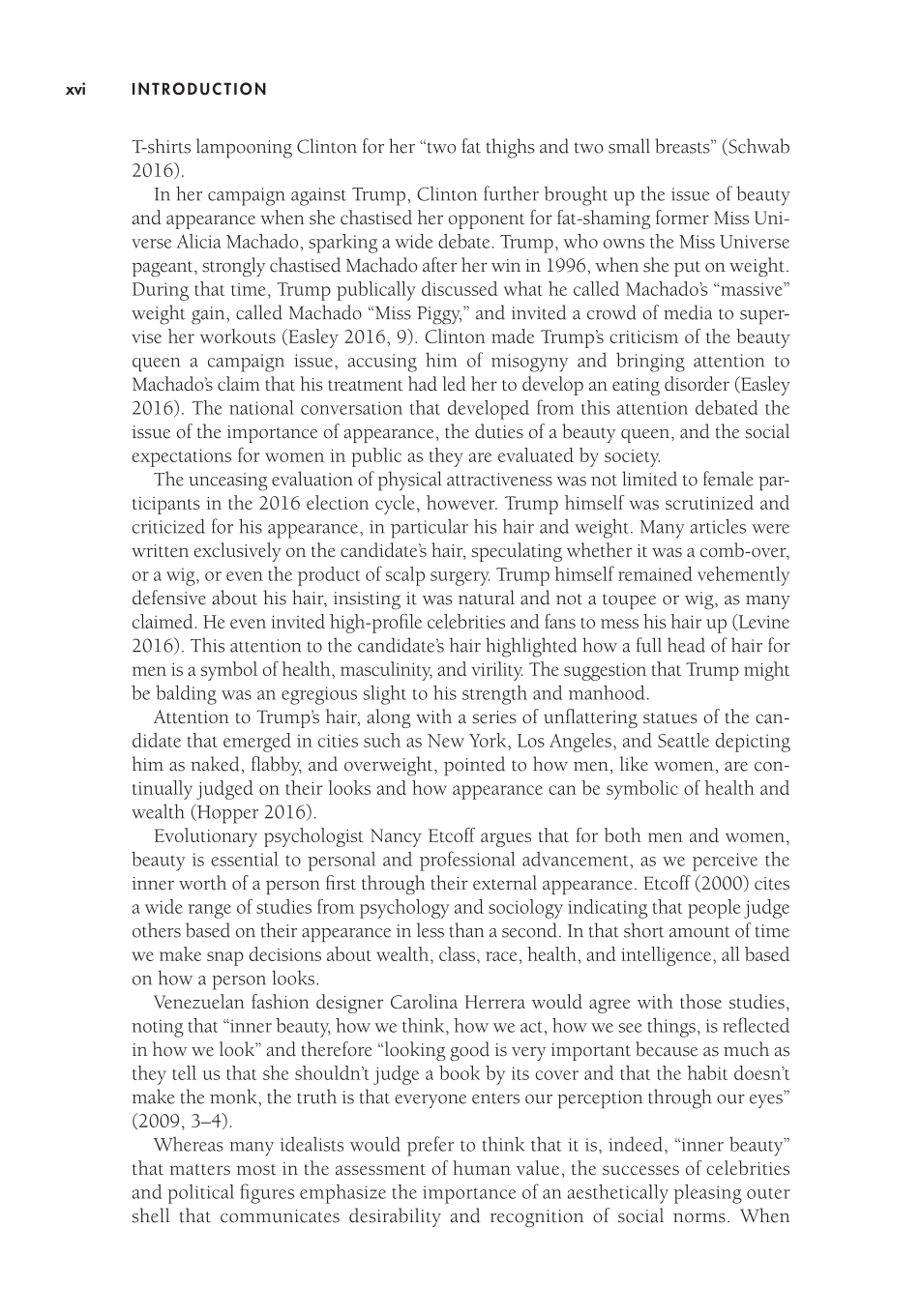Introduction xvi
T-shirts lampooning Clinton for her “two fat thighs and two small breasts” (Schwab
2016).
In her campaign against Trump, Clinton further brought up the issue of beauty
and appearance when she chastised her opponent for fat-shaming former Miss Uni-
verse Alicia Machado, sparking a wide debate. Trump, who owns the Miss Universe
pageant, strongly chastised Machado after her win in 1996, when she put on weight.
During that time, Trump publically discussed what he called Machado’s “massive”
weight gain, called Machado “Miss Piggy,” and invited a crowd of media to super-
vise her workouts (Easley 2016, 9). Clinton made Trump’s criticism of the beauty
queen a campaign issue, accusing him of misogyny and bringing attention to
Machado’s claim that his treatment had led her to develop an eating disorder (Easley
2016). The national conversation that developed from this attention debated the
issue of the importance of appearance, the duties of a beauty queen, and the social
expectations for women in public as they are evaluated by society.
The unceasing evaluation of physical attractiveness was not limited to female par-
ticipants in the 2016 election cycle, however. Trump himself was scrutinized and
criticized for his appearance, in particular his hair and weight. Many articles were
written exclusively on the candidate’s hair, speculating whether it was a comb-over,
or a wig, or even the product of scalp surgery. Trump himself remained vehemently
defensive about his hair, insisting it was natural and not a toupee or wig, as many
claimed. He even invited high-profile celebrities and fans to mess his hair up (Levine
2016). This attention to the candidate’s hair highlighted how a full head of hair for
men is a symbol of health, masculinity, and virility. The suggestion that Trump might
be balding was an egregious slight to his strength and manhood.
Attention to Trump’s hair, along with a series of unflattering statues of the can-
didate that emerged in cities such as New York, Los Angeles, and Seattle depicting
him as naked, flabby, and overweight, pointed to how men, like women, are con-
tinually judged on their looks and how appearance can be symbolic of health and
wealth (Hopper 2016).
Evolutionary psychologist Nancy Etcoff argues that for both men and women,
beauty is essential to personal and professional advancement, as we perceive the
inner worth of a person first through their external appearance. Etcoff (2000) cites
a wide range of studies from psychology and sociology indicating that people judge
others based on their appearance in less than a second. In that short amount of time
we make snap decisions about wealth, class, race, health, and intelligence, all based
on how a person looks.
Venezuelan fashion designer Carolina Herrera would agree with those studies,
noting that “inner beauty, how we think, how we act, how we see things, is reflected
in how we look” and therefore “looking good is very important because as much as
they tell us that she shouldn’t judge a book by its cover and that the habit doesn’t
make the monk, the truth is that everyone enters our perception through our eyes”
(2009, 3–4).
Whereas many idealists would prefer to think that it is, indeed, “inner beauty”
that matters most in the assessment of human value, the successes of celebrities
and political figures emphasize the importance of an aesthetically pleasing outer
shell that communicates desirability and recognition of social norms. When

























































































































































































































































































































































































































































